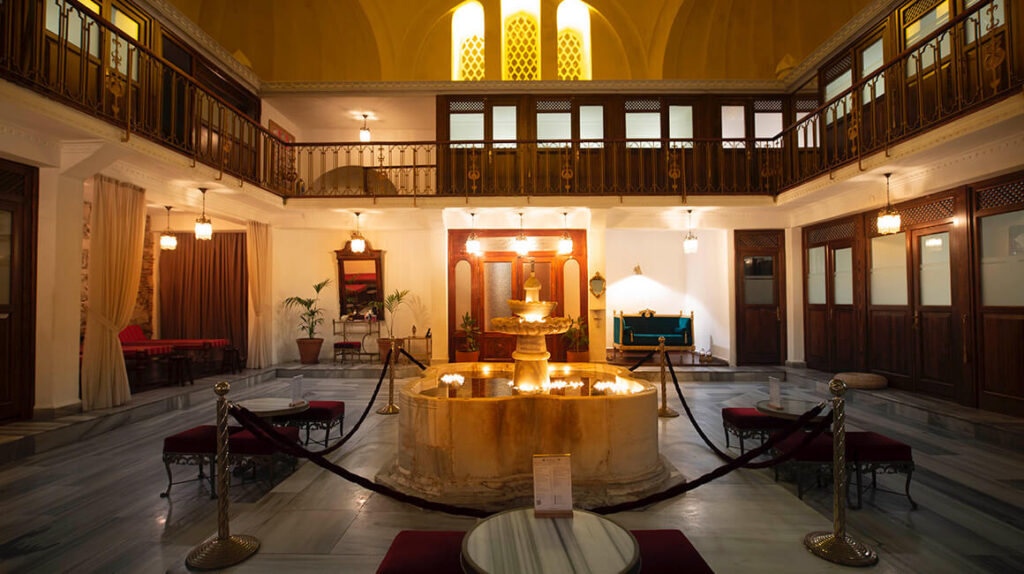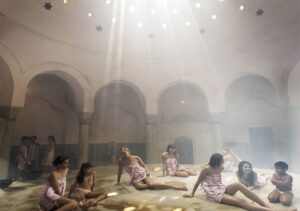
Price
City Tour
30
Any Language
Turkish Hammam ‘Cagaloglu Bath’; It was constructed in Istanbul Eminönü, in Alemdar, on Prof. Kazım İsmail Gürkan Street as a çifte public hamam to bring revenue for the library of Sultan Mahmut the first situated inside the mosque of Ayasofya. When we take a look at the names of the head architects of that time we can say that it was begun by Süleyman Ağa finished by Abdullah Ağa. It is the last example of it’s kind to be built in Istanbul and is a successful hamam that is still operational in our time. The door of the women’s section is on a side street called Hamam while the mens’ entrance is from the main road with two marble columns with classic stalactite capitals on both sides.
Step into the mystical world of the Turkish Hammam with a visit to the legendary Cağaloğlu Bath — a living monument of Ottoman culture and relaxation. Built in 1741 in the heart of Istanbul, this historic bathhouse is the last great hammam constructed during the Ottoman Empire, and it continues to welcome guests from around the world with its unique architecture and timeless rituals.
Located in Eminönü, just steps away from Hagia Sophia, Cağaloğlu Hammam was built by order of Sultan Mahmud I to generate

revenue for the imperial library. Designed as a çifte hamam (double bath) to serve both men and women, it remains a rare example of classical Ottoman bath architecture.
From the moment you enter through the grand marble columns of the men’s entrance or the elegant side street doorway to the women’s section, you are transported into a world of serenity. Inside, you’ll discover:
Each detail — from the seven-line poetic inscription above the entrance to the elegant fountains in the soğukluk (cooling room) — whispers the legacy of the Turkish Hammam tradition.
✅ Book your authentic Turkish Hammam experience at Cağaloğlu Bath now, and immerse yourself in a ritual that has soothed sultans, inspired poets, and captivated travelers for centuries.
This hammam is not only a spa — it’s a storybook. Folk poet Bitlisli Ali once worked here, and a legendary dream led him to a life-changing moment in these very walls. And today, the Cağaloğlu Bath stands proud as one of the oldest continuously operating companies in Turkey.
The Turkish Hammam experience offers more than relaxation — it’s a full-body renewal and cultural journey. Ideal after long travel days, it’s also a way to connect with centuries of tradition in one of the world’s most iconic cities.
After a full day exploring the wonders of your Istanbul tour — from the majestic Blue Mosque to the bustling Grand Bazaar — there’s no better way to relax than with an authentic Turkish Hammam experience.
Let the heat melt away your fatigue, enjoy a revitalizing scrub by skilled attendants, and soak in centuries of Ottoman tradition. The perfect end to your day, and the ultimate way to connect body and soul in the heart of Istanbul.
✨ Turkish Hammam: More than a bath — it’s a cultural ritual.
Experience a traditional Turkish Hammam at Istanbul’s iconic Cağaloğlu Bath (1741). Let expert attendants refresh your body and soul in a setting that reflects Ottoman elegance and ritual.
→ Perfect after long sightseeing days.
→ Mixed (men/women) services available.
Book now for an unforgettable wellness escape.
The Cağaloğlu hamam was constructed in 1741 and is the last hamam to be built after a long period during the Ottoman Empire.
In time when the street was elevated, the men’s section is reached by a staircase of 10 steps. The architecture of the door is contrary to eclectic Turkish style. On the tablet above the door is a long inscription of 7 lines and 28 verves. The high and wide camegah is joined to the large dome by segmented corner trumpet-like vault panels. In the middle is a pool with a waterjet of great artistic value. The windows are placed between the vault panels in threes. On the top of the dome is a lantern for illumination.
There is a şirvan in the camekan with rooms for undressing. The soğukluk is entered through a double door from the camekan and is covered with seven barrel vaults and a half sphere small dome. The domes are supported by arches and columns. There are eight arches on eight marble columns supporting the dome in the sıcaklık. In the center is the marble göbektaşı, surrounded by halvets in the four corners and three sofas in between the undressing room of the women’s section and the camekan of the men’s section. The beginning of the camekan and the soğukluk is different from classis plans. The soğukluk is also separated by two columns into three sections. In the middle there is a dome. The heat room is the same as in the men’s section. The külhan continues behind the wall of both heat room.
One of our folk poets Bitlisli Ali, had an interesting experience in this hamam where he first worked as a külhancı then as tellak. In his dream a 70 years old white bearded sheik is to go to a hammam and wash a tellak. At that where Ali worked was owned by Hacı Mustafa and the külhancı was a müslim. So the sheik choose to go to this hamam and after washing Bitlisli Ali, gave him a piece of gold. Ali kept the gold for good luck and never spent it in his life. According to a list made of the dates of company establishments, Cağaloğlu Hamam build 1741 is the oldest Turkish firms still active today. Evliya Çelebi states that in the second half of the 17th century there were 150 large and 150 small, totalling a number of 300 hamams were built for the use of the workers constructing other buildings of foundations. The revenue from these hamams were paid out as salary to the workers and for the preservation of the buildings.
34 Comments
The beauty of Istanbul took my breath away. Historical landmarks like the Blue Mosque and Hagia Sophia are even more impressive in person.
The whirling dervish performance was mesmerizing. It offered a glimpse into Turkey’s spiritual traditions.
We had a fantastic time haggling for souvenirs at the Grand Bazaar. It’s a shopper’s paradise!
The Istanbul Archaeological Museums house an impressive collection of artifacts from various civilizations.
The Istanbul Modern Art Museum showcases a diverse range of contemporary Turkish artists.
The Turkish baths, or hamams, are a must-try experience for relaxation and rejuvenation.
We took a leisurely stroll along the historic city walls, which offered panoramic views of Istanbul.
The Turkish desserts, especially baklava and kunefe, are heavenly. We indulged in them at local sweets shops.
The beauty of Istanbul took my breath away. Historical landmarks like the Blue Mosque and Hagia Sophia are even more impressive in person.
Attending a Turkish music concert introduced us to the mesmerizing sounds of traditional instruments like the oud.
We enjoyed sipping traditional Turkish tea at local cafes while people-watching in Istanbul’s vibrant neighborhoods.
Watching the sun set over the Bosphorus from the Ortakoy Mosque was a spiritual experience.
Exploring the historic streets of Sultanahmet and immersing ourselves in local culture was a highlight of our trip.
The Rahmi M. Koç Museum showcases Turkey’s industrial and technological history in a unique way.
Sampling street food like doner kebabs and mussels stuffed with rice was a delicious adventure.
The Aya Irini Church’s tranquility amidst the bustling city was a serene surprise.
Istanbul’s public parks and gardens offer peaceful retreats from the urban hustle and bustle.
Istanbul’s street food scene is fantastic. Don’t miss trying simit (sesame-crusted bread) and roasted chestnuts.
The Turkish desserts, especially baklava and kunefe, are heavenly. We indulged in them at local sweets shops.
The Turkish hospitality is heartwarming. We felt welcomed and embraced by the locals wherever we went.
The Istanbul Modern Art Museum showcases Turkey’s contemporary artistic talent.
We enjoyed a traditional Turkish dance performance and were impressed by the dancers’ skill and energy.
The whirling dervish performance was mesmerizing. It offered a glimpse into Turkey’s spiritual traditions.
Watching the sunset over the Bosphorus from the Ortakoy Mosque was a magical and spiritual experience.
The beauty of Istanbul took my breath away. Historical landmarks like the Blue Mosque and Hagia Sophia are even more impressive in person.
The Turkish cuisine is a delight for the senses. Don’t miss out on trying kebabs, baklava, and Turkish delight.
Istanbul’s street art scene adds a contemporary edge to the city’s historic charm.
Exploring the underground city of Derinkuyu in Cappadocia gave us a newfound appreciation for Turkey’s historical sites.
The Rahmi M. Koç Museum showcases Turkey’s industrial and technological history in a unique way.
Istanbul’s public parks and gardens are serene oases in the midst of urban life, perfect for a leisurely stroll.
Our guide’s passion for Istanbul’s history was contagious. We learned so much and felt a deeper connection to the city.
Sampling Turkish street food was a culinary adventure. We loved trying gözleme and stuffed mussels.
The Turkish coffee is strong and delicious. Sipping it at a traditional coffeehouse is a cultural experience.
The Chora Church’s exquisite mosaics and frescoes left us in awe of Byzantine art.